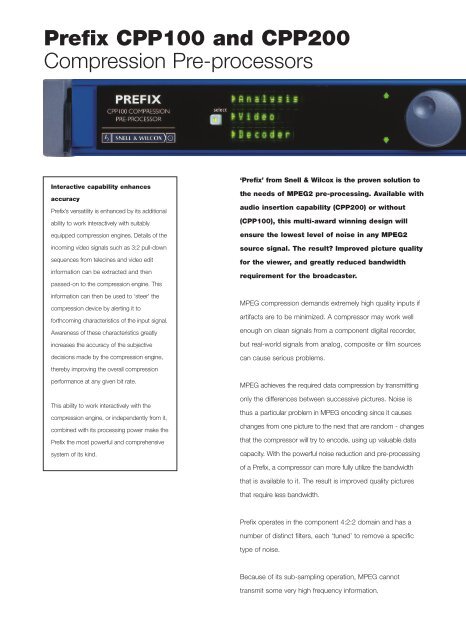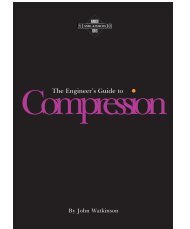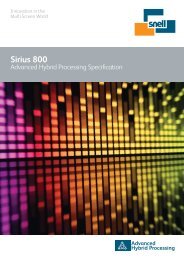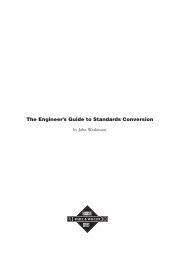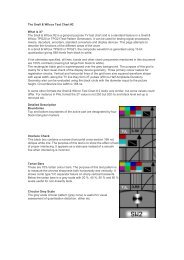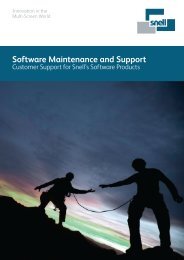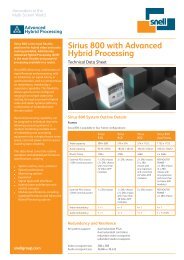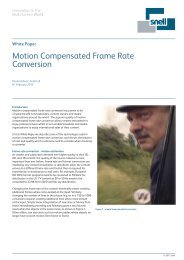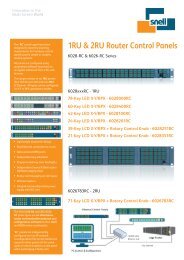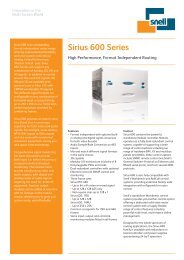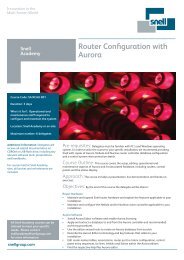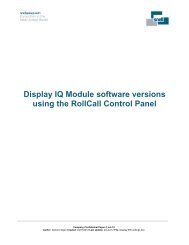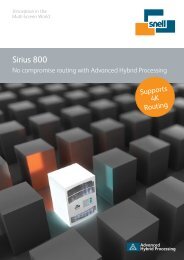Signal Processing - Snell
Signal Processing - Snell
Signal Processing - Snell
Create successful ePaper yourself
Turn your PDF publications into a flip-book with our unique Google optimized e-Paper software.
Prefix CPP100 and CPP200<br />
Compression Pre-processors<br />
Interactive capability enhances<br />
accuracy<br />
Prefix’s versatility is enhanced by its additional<br />
ability to work interactively with suitably<br />
equipped compression engines. Details of the<br />
incoming video signals such as 3:2 pull-down<br />
sequences from telecines and video edit<br />
information can be extracted and then<br />
passed-on to the compression engine. This<br />
information can then be used to ‘steer’ the<br />
compression device by alerting it to<br />
forthcoming characteristics of the input signal.<br />
Awareness of these characteristics greatly<br />
increases the accuracy of the subjective<br />
decisions made by the compression engine,<br />
thereby improving the overall compression<br />
performance at any given bit rate.<br />
This ability to work interactively with the<br />
compression engine, or independently from it,<br />
combined with its processing power make the<br />
Prefix the most powerful and comprehensive<br />
system of its kind.<br />
‘Prefix’ from <strong>Snell</strong> & Wilcox is the proven solution to<br />
the needs of MPEG2 pre-processing. Available with<br />
audio insertion capability (CPP200) or without<br />
(CPP100), this multi-award winning design will<br />
ensure the lowest level of noise in any MPEG2<br />
source signal. The result? Improved picture quality<br />
for the viewer, and greatly reduced bandwidth<br />
requirement for the broadcaster.<br />
MPEG compression demands extremely high quality inputs if<br />
artifacts are to be minimized. A compressor may work well<br />
enough on clean signals from a component digital recorder,<br />
but real-world signals from analog, composite or film sources<br />
can cause serious problems.<br />
MPEG achieves the required data compression by transmitting<br />
only the differences between successive pictures. Noise is<br />
thus a particular problem in MPEG encoding since it causes<br />
changes from one picture to the next that are random - changes<br />
that the compressor will try to encode, using up valuable data<br />
capacity. With the powerful noise reduction and pre-processing<br />
of a Prefix, a compressor can more fully utilize the bandwidth<br />
that is available to it. The result is improved quality pictures<br />
that require less bandwidth.<br />
Prefix operates in the component 4:2:2 domain and has a<br />
number of distinct filters, each ‘tuned’ to remove a specific<br />
type of noise.<br />
Because of its sub-sampling operation, MPEG cannot<br />
transmit some very high frequency information.


